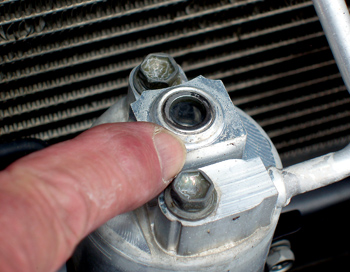lified technician or shop owner knows that changing engine oil is only part of any scheduled maintenance procedure. Instead of selling marginally profitable oil changes, many shops are now basing their recommendations on the auto manufacturer’s suggested inspection and maintenance schedule. In any case, I’m going to add to that list by suggesting inspections that will increase the overall profitability of the typical import specialist shop.
VISIBILITY COMPONENTS
A visibility inspection includes an inspection of the front and rear windshield wipers, wiper fluid reservoir levels, washer/wiper motor functions and windshield glass condition. A quick test of the wiper and washer functions will usually reveal badly pitted or extremely dirty windshields. If you market in extremely cold climates, make sure that the wiper fluid is properly formulated for sub-zero operation.
A second level of visibility inspection would be to check all exterior and interior lighting functions, including the emergency flashers. Keep in mind that because exterior lighting is often controlled by one or more body control modules (BCMs), a scan tool might be the appropriate tool for diagnosing exterior lighting malfunctions. Lenses should be inspected for brightness and damage. Headlamp covers should be inspected for weathering and water leakage. See Photo 1. 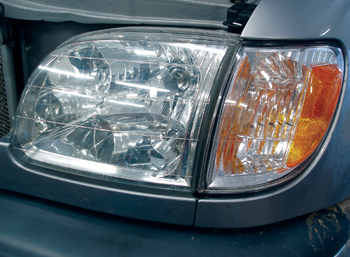
FLUID INSPECTION AND REPLACEMENT
Although auto manufacturers have nearly eliminated all scheduled fluid replacements, vehicles should still have the axle oil changed after extended exposure to high water levels encountered on off-road fording or flood-stage conditions. Automatic transmission fluid change intervals should also be shortened if the vehicle is used for heavy towing or has been exposed to flood-stage water.
Most coolants are now long-life or “lifetime” formulations. Here again, the experience of the shop’s techs comes into play if it encounters premature cooling system corrosion and other fluid deterioration situations. Always install a coolant that’s compatible with the manufacturer’s recommendations.
Brake fluid flushing is recommended by some manufacturers and can also be justified by using brake fluid test strips or spectrometers to determine moisture levels. Power steering fluid should also be replaced if it appears excessively dirty, contaminated or oxidized. Keep in mind that, while some fluids are suitable for “topping off” fluid levels, they don’t meet “replacement” specifications. All replacement fluids should meet OE specifications.
BELTS AND HOSES
Because modern rubber formulations are far more durable than in years past, it’s difficult to recommend specific replacement intervals. In most cases, hoses are still serviceable if they are pliable and not cracked or swelled at the connections. Because modern EPDM technology has nearly eliminated cracking in drive belts, the belts should be tested for wear with a simple tool available from various manufacturers. See Photo 2.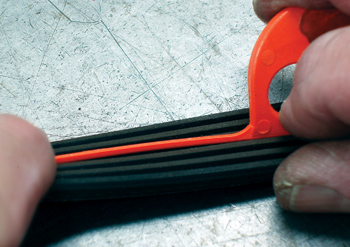
In some applications, even a minor amount of rib wear can contribute to a loss of tension and slippage. Timing belts should be replaced according to the manufacturer’s suggested intervals. If a timing belt replacement is recommended, accessory drive belts and hoses should be considered for replacement, especially on high-mileage vehicles.
BATTERY TEST
Because electronic engine controls and permanent-magnet starters dramatically reduce cranking amperage, a bad battery can survive well past its normal service life. Unfortunately, a bad battery fails only when the vehicle owner least expects it. Electronic battery testers can quickly test battery capacity, starter condition and alternator output. If on-board electronic interference prevents the use of an electronic tester, the conventional carbon pile load tester is a good substitute for testing a suspect battery.
In most cases, battery reliability rapidly declines about four years after installation. In addition, extreme heat and vibration will dramatically shorten battery life. If nothing else, check the installation date on the battery and make recommendations based on your own experience. See Photo 3.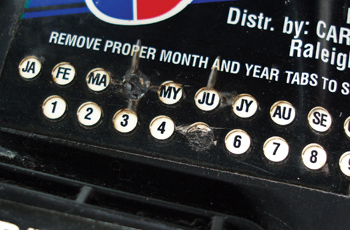
WHEELS AND TIRES
Because of tire pressure monitoring system (TPMS) requirements, tire pressure should be adjusted to manufacturer’s specifications. If the TPMS warning light is illuminated, the vehicle has a leaking tire or valve stem. Tires should also be visually inspected for excessive tread wear, cuts, uneven tread wear, excessive weathering and casing defects. Tires should also be inspected for mismatching sizes and diameters. In some cases, one or two inches difference in the rolling circumference of the tire can prematurely wear viscous couplings in all-wheel-drive vehicles and the drivetrain in four-wheel-drive vehicles. Tire mismatches also might interfere with correct operation of the vehicle’s anti-lock brakes and stability controls. Wheels should also be visually inspected for physical damage. Re-torquing the lug nuts to specification is always recommended. See Photo 4.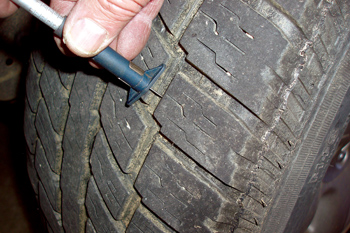
STEERING/SUSPENSION/EXHAUST INSPECTION
Most import manufacturers specify undercar inspections in their maintenance schedules. Visually check for loose bolts, torn axle shaft CV boots, swollen or leaking steering rack bellows, leaking shock absorbers or struts, worn rubber bushings, and rusted or damaged exhaust systems.
With the wheels suspended, grasp the tire at the 9 and 3 o’clock positions and alternately turn it right and left. The steering linkage shouldn’t show any looseness or binding as the wheels are turned. Next, grasp the tire at the 12 and 6 o’clock positions and attempt to tilt it in and out. The wheel shouldn’t show any looseness in the bearings or ball joints.
Last, test the suspension for rebound by placing your hands on the radiator core support or bumper. Placing hands on the hood can dent the sheet metal. Suspension travel should be smooth and quiet and rebound should recover in one cycle.
BRAKE INSPECTIONS
A shop should have the customer’s permission to remove the wheels for brake inspection. But an alternative strategy is to inspect the master cylinder reservoir for low fluid level. A low level might indicate excessive brake pad wear or a system leak. See Photo 5.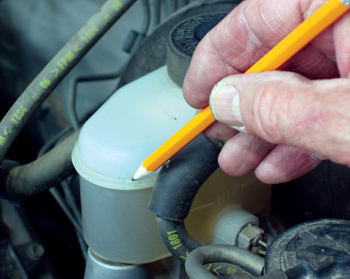
If the fluid is opaque, the system should be flushed. Excessive brake dusting or metallic deposits on spoke wheels often indicate metal-to-metal contact at the brake pads. In most cases, worn pads can be detected by using a flashlight to check brake pad wear. Last, check brake pedal height and firmness. If applying the park brake remedies a low brake pedal, the ratcheting assembly in the caliper pistons might be seized.
THE POWER OF OBSERVATION
Most of the above procedures are based upon the powers of observation. Consequently, it’s important to have experienced people manning the lube bay. One shop I visited years ago, hired two semi-retired mechanics to service vehicles and perform lube-bay inspections. Those two men kept a five-bay shop busy with mechanical repair work. See Photo 6.